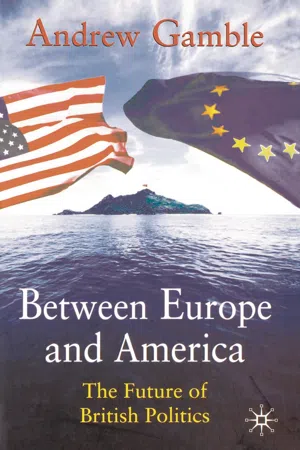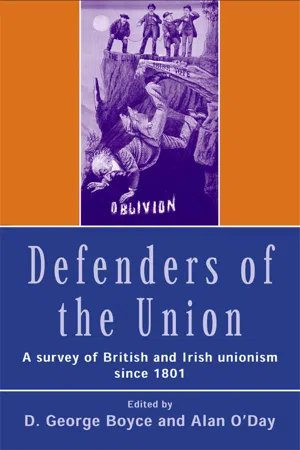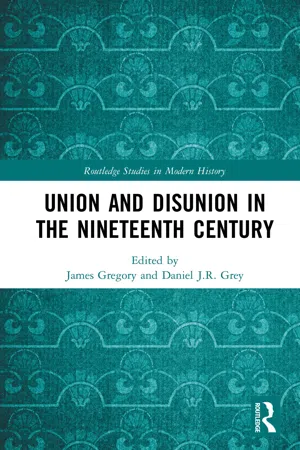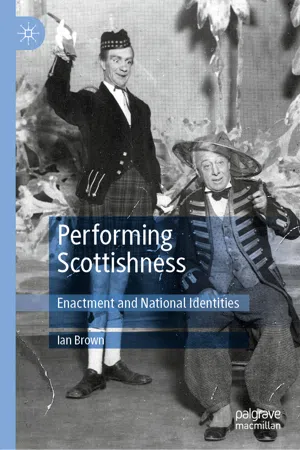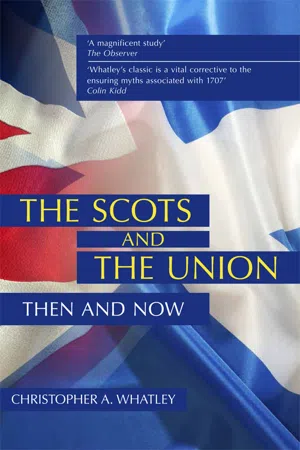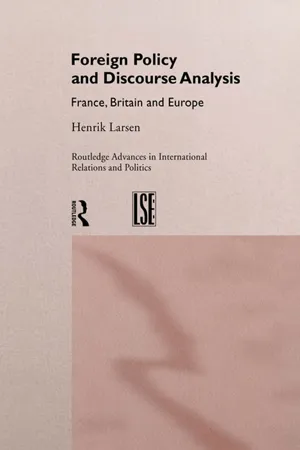History
The Union
The Union refers to the United States of America, specifically the federal government and the collection of states that form the nation. It was established through the ratification of the US Constitution in 1787 and has since served as the central governing authority for the country. The concept of the Union has been central to American history, politics, and identity.
Written by Perlego with AI-assistance
Related key terms
1 of 5
8 Key excerpts on "The Union"
- eBook - PDF
Between Europe and America
The Future of British Politics
- Andrew Gamble(Author)
- 2017(Publication Date)
- Red Globe Press(Publisher)
The Union is the first circle within which England 40 stands, the first of the transnational spaces which has shaped British history and politics, and has defined Britishness. Strong claims of exceptionalism are often linked to the history of partic-ular states and most often arise in those nations in which the history of the nation and the history of the state are closely intertwined, and in which the state has played a major role in nation-building. This is true of the United States 2 and it is also true of the United Kingdom. 3 The idea of an overar-ching British ÔnationÕ and therefore a separate British identity was fostered by the government of this new state after the Act or Treaty of Union between England and Scotland in 1707, just as an overarching American nation and American identity were fostered by the federal government after the American Civil War. Governments have not been slow to understand the powerful legitimation that nations provide for states in the modern era. Where a state has lacked an appropriate nation to underpin it the natural impulse of its governing class has been to encourage one to form. 4 Even where nations already existed as cultural and ethnic entities, they often had to be reconstructed if they were to perform the role which states required. This explains why states have at times been so keen to crush national and ethnic groups which do not fit into their plans or which they judge to be incapable of assimilation. The nation-states of the last three hundred years are political constructions rather than natural phenomena. Nations have often been remodelled by states, and sometimes they have been called into existence by states. 5 A major problem therefore arises when the national identity on which the legitimacy of the state has been founded starts to crumble. Many think such a fate is beginning to overtake the United Kingdom. - Mark Towsey(Author)
- 2019(Publication Date)
- Cambridge University Press(Publisher)
chapter 4 A Nation United? Histories of England, Ireland, Scotland and Wales The 1700s were a pivotal century in the formation of the modern United Kingdom, bookended by the Anglo-Scottish Union of 1707 and the Anglo- Irish Union of 1800–01. Scholars have demonstrated that the 1707 Union had a profound effect on how the bestselling British histories of the period were written. The Scottish-born historians David Hume and William Robertson believed The Union to be a thoroughly good deal, bringing Scotland at long last into fruitful partnership with England’s historic wealth and much more robust parliamentary traditions. Their histories encouraged readers to set aside exclusive national identities in favour of new ‘Anglo-British’ forms of identity, employing a number of narrative strategies designed to smooth over historic points of friction and to con- vince readers in all parts of the United Kingdom that they were ultimately far better off together than they had been apart. 1 In case they had missed this message, Robertson spelled out precisely how The Union had ‘ren- dered’ the British as ‘one people’ in the final paragraph of his History of Scotland, emphasising the role played by books like his: The distinctions which had subsisted for many ages gradually wear away; peculiarities disappear; the same manners prevail in both parts of the island; the same authors are read and admired; the same entertainments are frequented by the elegant and polite; and the same standard of taste, and of purity in language, is established. 2 There can be few contemporary readers for whom such strategies were so personally relevant as they were for John Murray, an MP for Perthshire who would succeed as 3rd Duke of Atholl in 1764. Murray’s past was intimately bound up with Scotland’s turbulent post-Union legacy: he was 1 Kidd, Subverting Scotland’s Past; Colin Kidd, ‘The Ideological Significance of Robertson’s History of Scotland’, in Brown (ed.), William Robertson, pp.- eBook - ePub
Defenders of the Union
A Survey of British and Irish Unionism Since 1801
- D.George Boyce, Alan O'Day(Authors)
- 2002(Publication Date)
- Routledge(Publisher)
Absorption of Ireland into The Union caused an upheaval in Great Britain for it introduced a substantial enclave of Catholics into a Protestant, and in 1801, confessional state. This challenge to national identity spurred the search for a viable new ethos based on a multinational, religiously tolerant and pluralistic community. The literature on nationalism tends to emphasise the rise of nascent or emergent ‘communities’ with the demand for a distinctive ‘national state’ corresponding to the ‘nation’. Nationalism, thus, is pitted against the rival claims of the currently dominant state. However, the defence of The Union demonstrates that dominant states faced with emergent ‘nations’ within their own boundaries strive to reinvent themselves by much the same process. As The Union was the cornerstone of a state based on the incorporation of the whole of the British Isles, notions about its legitimacy, utility and content were vital to the formulation of a new ‘nationality’ - British - not merely English, Welsh, Scottish or Irish. Four issues ran through in the Irish controversy in the nineteenth century - responses to the Protestant ecclesiastical establishment; political legitimacy based on numbers; the nature of citizenship; and whether Irish Catholics could be integrated into the fabric of the community. These were not questions admitting to simple answers and their outcome was vital to establishing whether a unified culture or a multinational, religiously diverse pluralist community should be the goal. The Union was an important ingredient in the debate.The parliamentary discussions on the Irish Church Bill in 1869 and the Government of Ireland Bill in 1886 illuminate and amplify the problems of identity, centring on conceptions of The Union. Although in 1869 only the confessional link in the Act of Union was openly challenged, the wider question of what constituted a United Kingdom and The Union was taken up implicitly; in 1886 under the impact of a direct threat to The Union these points were raised explicitly. Though there was a parallel public discussion, the key themes were articulated during parliamentary debates. In the later Victorian era Parliament, particularly the House of Commons, had an exceptional place in political culture. Walter Bagehot’s contemporary The English Constitution pointed out that the House of Commons was the ‘efficient’ part of the constitution, the cockpit of responsible government with five major functions, of which three -expressing of the mind of the nation ‘on all matters which come before it’; teaching the country ‘what it does not know’; and informing the sovereign people of complaints and grievances - lay at the heart of the debates of 1869 and 1886.14 During the discussion of the proposed home rule measure Gladstone employed the forum of Westminster as a school room. Speakers on the Church Bill in 1869 sought to express the mind of the nation ‘on all matters which come before it’ and inform the sovereign people of complaints and grievances about the ecclesiastical establishment in Ireland. As Lord Henry Scott observed, ‘true, it was not possible for the opponents of the Bill to defeat it by a numerical majority; but it was nevertheless their duty, both as a party and as men holding conscientious views on the subject, to strive to have the country well informed upon the whole matter’.15 - eBook - ePub
- James Gregory, Daniel Grey, Daniel J.R. Grey(Authors)
- 2019(Publication Date)
- Routledge(Publisher)
Part IIIThe politics of union and disunion in Great Britain
Passage contains an image
Gordon Pentland5 Scottish political leadership and Anglo-Scottish union in the long nineteenth century
Introduction
Few could doubt that both unions of various description and leadership are contemporary obsessions. Historians of Scottish politics have, of course, long been interested in the first of these in the shape of the Anglo-Scottish union of 1707, its causes, course and consequences. Recent decades have witnessed a far more nuanced and variegated history of that union and of the various unionisms and nationalisms (the plural form is important here) that held it as a central point of reference.1This effort has gone some way to address a wider problem: the poverty of explicitly political history within postwar Scottish historical studies. Michael Fry (himself, significantly, an excellent political historian, but one sitting somewhat outside of the academic profession) lamented this a long time ago.2 The thinness of Scotland’s political history (especially, but not only, for the nineteenth century) has been compounded by its unevenness. Historians have sought out ‘progressive’ themes (liberalism or radicalism) or otherwise been on the hunt for nationalism. The casualties from this unbalanced historiography should be obvious. Much more ink, for example, has been spilt on the National Association for the Vindication of Scottish Rights (NAVSR) – a small, short-lived and cranky protest movement – than on the Conservative Party in nineteenth-century Scotland.3An additional absence here is any study of specifically Scottish political leadership. This is a theme well represented within British political historiography as a whole, perhaps most notably in the well-known Anglophone appetite for political biography. More recently, existing ways of approaching political leadership within history have been cross-fertilised by insights from politics disciplines, anthropology and elsewhere.4 - eBook - ePub
Performing Scottishness
Enactment and National Identities
- Ian Brown(Author)
- 2020(Publication Date)
- Palgrave Macmillan(Publisher)
14To be fair, it has often seemed to suit both signatories to the Treaty of Union since the 1706–1707 settlements not to resolve such thorny issues too clearly. Moreover, Goldie points to a later nineteenth-century phenomenon which certainly has its roots before The Union and continues to prevail: ‘The presence of influential Scottish people in England, and powerful English people in Scotland, created not only a hybrid or synthetic Britishness, but also an alteration in the nature of both England and Scotland themselves’.15 Attempts in the seventeenth century—like that in 1606 by James VI and I —to bring about parliamentary union had failed because of fundamental differences between the two national communities’ sense of their identity and rights. The treaty was only deliverable in 1707 because it was accepted that it was still not possible to resolve those differences. Let us remember that a key trigger for The Union was not a powerful sense of common identity, but, arguably, the sectarian wish to protect the protestant succession after the Scottish Parliament had passed an act making it clear it retained the right to nominate a different sovereign to England. Queen Anne and the protestant establishment forced through The Union against popular resistance in both countries, while preserving the economic interests of the negotiating classes. An element in these interests was a desire to obviate the impact of the failure of the 1698–1699 Darien scheme where a Scottish attempt to set up a colony had been thwarted by poor Scottish planning, Spanish hostility and English blockade. The Treaty’s overarching aim was to produce a political settlement that would sustain commercial and, post-Darien, colonial development as well as, so far as possible, a peaceful settlement between the two signatory nations. Since 1707, as we have noted, the tendency has been to talk of the process of union as the result of an ‘Act of Union ’, as if there were only one. This has created the sense of a unifying single act, usually seen as that passed at Westminster . Hence, perhaps the confused Home Office farrago just cited. Relegated into the background is the fact that, rather than being simply a unified nation-state as might have existed after an act of conquest or, indeed, outright colonialism, the United Kingdom is based on an alliance treaty between two sovereign states. Further, the nature of that alliance was changed in 1800/1801 by Ireland’s formal inclusion and, over a century later, by the withdrawal of the bulk of Ireland in 1922. Perhaps part of the point of this procedure is that an Act of the parliament sited where the joint parliament now sits can easily be misrepresented as an Act of the new 1707 parliament. To foreground the performative act which generated the ‘United Kingdom’ as a treaty would highlight its international nature. It also would admit the potential impact of Charles de Gaulle’s cynical and somewhat sexist view of the evanescent nature of such agreements: ‘Treaties are like roses and young girls. They last while they last’.16 - eBook - PDF
The Scots and the Union
Then and Now
- Christopher Whatley(Author)
- 2014(Publication Date)
- Edinburgh University Press(Publisher)
introduction 23 Home Secretary – that The Union of Scotland with England had resulted in ‘com-mercial prosperity, unknown to any people’. In addition, Bruce was convinced that The Union had consolidated the strength of the British nation, enabling Britain to ‘preserve the balance of power in Europe for a century’. In the circumstances of the time, it is understandable, too, that he should have celebrated Britain’s ability to ‘maintain its own power and trade against the unprincipled Republic of France, now sweeping before it the venerable fabric of ancient arts and civilisation’. 101 The Whiggish voices of unionism triumphant, which rasp uncomfortably in our present, post-colonial age, were to be heard once again over a century later in the aftermath of Britain’s victory over Germany in the so-called Great War during 1914–18. Historians, too, tracing the taproots of Britain’s imperial hegemony, have invariably found that one of them was The Union of 1707, although the more prudent of them have observed that the incorporation model was one of several in Europe and that Britain’s ascendancy was by no means inevitable. 102 The social costs of partnership within the British state were high, however, not least because the Scots often worked for lower wages (allied to high levels of skill in key industries) to secure their place in Britain’s world-leading workshops. As Britain’s economic wings were clipped in the twentieth century, the benefits of The Unionist partnership became less apparent to the Scots, who were poorer than their English counterparts and, in terms of social infrastructure, less well-equipped to deal with relative decline. 103 After the deleterious economic consequences of the First World War began to bite, and as Scotland’s great staple industries lost their competitive edge and unemployment mounted, the mood shifted. - eBook - PDF
- Tom M. Devine(Author)
- 2008(Publication Date)
- Edinburgh University Press(Publisher)
5 THE LEGACY OF UNIONISM IN EIGHTEENTH-CENTURY SCOTLAND Alexander Murdoch The tercentenary of British parliamentary union has led to more inter-est in the legacy of that union in Scotland than England, but should this surprise us? There was no English interest in union with Scotland after the arrival of a Scottish king to take the throne of Scotland in 1603, and the incorporation of Scotland into the Cromwellian pro-tectorate after 1652 was based on military conquest. As Maurice Lee wrote about the English rejection of James VI & I’s plans for British union after 1603: ‘The Union would mean more Scots, quarrelsome, beggarly, covetous, and proud, in England’s green and pleasant land. The English wanted none of it’. 1 In 1604 Sir Edwin Sandys ‘argued that an English parliament could not make decisions about “Great Britain” alone, and spoke of English precedency “believing that Scotland should yield and take the famous name of England” ’. 2 Bruce Galloway wrote that English assumptions of superiority to Scotland ‘went beyond the stereotypes of English riches and Scots poverty. Material fortunes merely confirmed the feudal and indeed moral supremacy of the southern kingdom’, although he did note that there were those in both nations in 1603, as there would be 1707, who hoped that ancient animosities might be overcome. 3 During debates over naturalisation of Scots in the English House of Commons in 1607 Sir Christopher Piggot, MP for Buckinghamshire, ended his speech against the proposal by concluding with ‘a bye-Matter of invective against the Scots and Scottish nation; using many words of obloquy’ including the assertion that the Scots ‘have not suffered above two kings to die in their beds, these two hundred years’. 4 In short, opposition in the English House of Commons in 1607 made it impossible for King James of England to argue that the English would willingly consent to union with his original kingdom. - eBook - ePub
Foreign Policy and Discourse Analysis
France, Britain and Europe
- Henrik Larsen(Author)
- 2005(Publication Date)
- Routledge(Publisher)
The most important driving force behind the political unification process can be interpreted as English conquest and political pressure (although in the case of Wales and Scotland there were also strong forces in favour of The Union within these two countries). It was greatly facilitated by the already existing royal unions, first between England and Wales, later between England and Scotland (Clark 1991: 59).The consequence of the Acts of Union was essentially that the other countries were integrated into the English political system (concretely the English unwritten constitution), although Scotland was allowed to keep elements of its own system (but not its own parliament). The important political processes became centred around London. The British state was unitary. It contained very few elements of federation. None of the countries in it retained even a modified sovereignty (Nairn 1981: 13). There were challenges to this unitary state: Scottish rebellions in the eighteenth century, the Irish home rule debate in the late nineteenth century (which was also a debate about home rule for Wales and Scotland) and the proposals for devolution in the 1970s (rejected in the 1979 referendum). The state has, however, largely remained politically and administratively unitary with the exception of the functioning of the Stormont parliament in the fifty years from 1920. Compared to France (see chapter 3 ), the unitary state did, to a larger extent, accept civil/cultural variety in the different countries composing it. It even to some extent encouraged the expression of cultural differences as long as they did not become politically salient (Crick 1991: 90-91). Nairn writes thatThere were not the same structured efforts to create a uniform culture as in the case of France (Johnson 1977: 81).There were examples of forced levelling, for instance in Wales and in the Scottish Highlands; yet in the main “Anglicization” was confined to the slower, more gradual impact of one large central nationality upon the smaller peripheric areas.(Nairn 1981: 12)The English, and later the British, state was in comparison with other states on the European continent, in particular the French, relatively noninterventionist (but highly centralised). It was a nightwatchman state. This is one possible reason for the relatively infrequent use in British political discourse historically of the term ‘state’ let alone the ‘British state’ (Dyson 1980: 37). This has also been linked by some to a very strong English individualist tradition of which a non-interventionist state is the mirror image (Crick 1991: 94). The state was seen as an entity to serve individual well-being rather than as a mythical entity in its own right.
Index pages curate the most relevant extracts from our library of academic textbooks. They’ve been created using an in-house natural language model (NLM), each adding context and meaning to key research topics.
